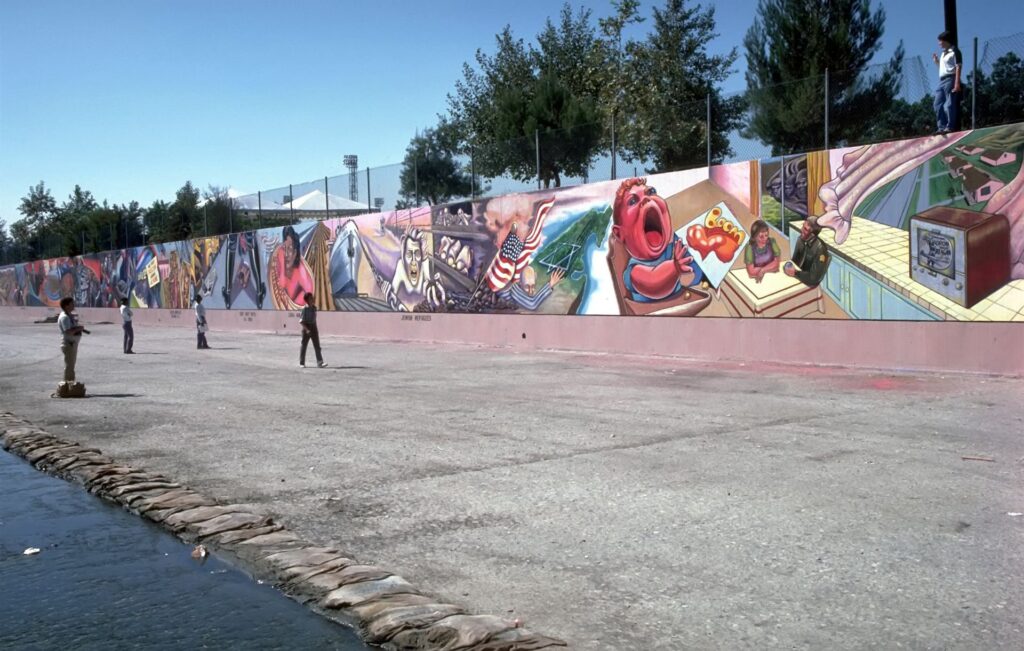A Monuments Project grant will enable artist Judith F. Baca and her community collaborators to add chapters to the “Great Wall of Los Angeles.” In this guest essay, Baca describes the impetus behind the decades-long project.
Bienvenidos a El Pueblo de Nuestra Señora la Reina de Los Ángeles del Río de Porciúncula, otherwise known as “El Lay” in street vernacular. I am a born and raised Angelita, increasingly a minority in our city of immigrants, where most Angelenos are now from elsewhere and do not know its original name or history.
I was born in Watts, where I lived with my mother, grandmother, and two aunts at a time when Watts was largely inhabited by African Americans who migrated from the south to urban centers after the Second World War. The 1965 Watts uprising, still charred into the city’s landscape, was one of the largest in American history, and was caused by the same inequities that led to the uprising of 1992. My first art experience was seeing Simon Rodia climb the towers in Watts (which the artist called “Nuestro Pueblo”) with broken dishes strapped to his belt to create one of the first public artworks in Los Angeles. Today there is a school named for me just five blocks from my family’s tiny one-bedroom duplex six blocks from the towers. In the intervening years, the community has shifted demographically; as of the 2010 census Watts is now more than 74 percent Latino but has remained largely unchanged in its poverty status and living conditions. The Judith F. Baca Arts Academy, a Los Angeles Unified School District school, is a statement from the community about their aspirations that their children be encouraged to defy expectation and to dream creatively.
Our beautiful city is a giant stretching nearly 50 miles across, from the lush green gardens at the ocean’s edge to the arid inland deserts. Its diversity of landscape parallels that of its people. With 94 languages other than English spoken in city schools and 225 languages in the city at large, LA is home to the largest diasporas of people from many countries, including Mexico, El Salvador, the Philippines, Korea, and Thailand. The only city that exceeds Los Angeles in its Mexican population is Mexico City.
The story of Los Angeles, like many great cities, begins on the banks of its river. Remnants of the Zanja Madre (Mother Trench) have just recently been excavated near Chinatown’s edge, marking what became Sonoratown, named for the first pobladores from Sonora. The Los Angeles River, like many rivers in drought-prone regions, expanded and contracted in the rainy season. The original Chumash and Tongva—“the people of the Earth”—accommodated the river and lived for thousands of years along its banks.

I dreamed of a “tattoo on the scar where the river once ran,” and an endless narrative that would recover the stories of those who were disappeared along with the river.
JUDITH F. BACA
Memories of our origins are still embedded in our land, but now mostly only appear as apparitions in the landscape. They are Spanish language or native names that appear on your GPS while driving down the “San Diego” freeway toward the “San Fernando Valley,” or on your way to “Topanga Canyon” and “Pacoima.” The names call us to another time as we transverse the land between the founding missions of San Gabriel de Arcángel and the Mission San Fernando rushing in our cars across the city on the long-traveled Camino Real route planned to be a one-day horseback ride apart by the Spanish missionaries around 1770.
Since its founding alongside of the Los Angeles river, the river caused numerous floods, even washing away the original pueblo in 1815 and again, in 1861, the entire San Fernando Valley flooded. After particularly bad flooding in 1938, the city fathers determined that the river needed to be tamed. The river had overflowed its allotted space and destroyed valuable real estate, by then already LA’s most valuable commodity. The 1940s began a decades-long process of concreting the Los Angeles River.
When the 20-year-long concreting project was complete, it was the largest public works project in America. Its completion gave rise to the Aesthetic Recovery Division at the Army Corps of Engineers. Its purpose was to deal with the effects of the concreted arroyos. They were eyesores. They’d created dirt belts along the river and divided communities. The concreted river, of course, had many other serious consequences. It carried runoff water too swiftly to the ocean, bearing pollution from our city streets, affecting the Santa Monica Bay, and depriving the aquifer of water replenishment.
In the 1950s my stepfather became an aircraft worker after leaving the service, and my family moved from Watts to a restricted housing covenant in Pacoima, designated for minority workers in the aircraft industry. As a child I watched as the river—the arteries of the land—was hardened into concrete conduits and miles of arroyo disappeared. I think I can trace the beginnings of my career as a political landscape painter to growing up alongside the Los Angeles River.
Standing at the river’s edge, I saw the concreted arroyos as scars in the land. I dreamed of a “tattoo on the scar where the river once ran,” and an endless narrative that would recover the stories of those who were disappeared along with the river. How could we recover the memory recorded in the land? This began my years of working with more than 400 youth and hundreds of descendants of the original peoples in the Los Angeles River, recovering, through the creation of visual histories, all that had disappeared. Through our ongoing narrative work,The Great Wall of Los Angeles, we are attempting to heal both the river and the people. Currently measuring one half-mile, The Great Wall is an evolving chronology of memory from the land recorded with our hands and paint, and now flowing along the river where it all began.
Read from the source – Mellon Foundation